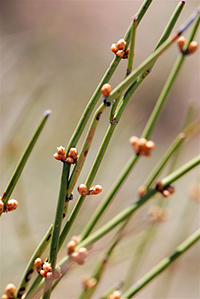Table of Contents
The Mormon tea plant may be the medicinal herb used for the longest time. It was first known in China, where it was called mahuang, and the Chinese had used it for several thousand years. Western medicine did not discover this plant until the 19th century. In 1926, its active principle, ephedrine, was first synthesized by Merk Laboratories in Germany. Since then, it has become part of several medicines.
- Loose Leaf Wild Herbal Tea, Mildly Sweet, Reported Medicinal Uses, No Ephedrine, No Caffeine, No Additives, All American Product
- Origin: Western United States, Washed, Dried, Ready To Use | Enjoy & Please Add Your Feedback | Thanks!
- Tasty Sustainably Wildcrafted Tea | Various Medicinal Uses | Naturally Sweet & Refreshing

Healing Properties and Warning
The whole plant contains ephedrine, an active alkaloid that acts on the nervous system, tannin, saponin, flavons, and an essential oil. Ephedrine acts in a way similar to adrenaline, stimulating the sympathetic nervous system (sympathomimetic action). It increases blood pressure, produces tachycardia, relaxes the bronchial muscles, increases perspiration and gastric and salivary secretions, and provokes mydriasis (dilation of pupils).
Its most crucial medical use is for bronchial asthma due to its bronchodilator effect and allergic reactions (nettle rash, hay fever, etc.) since it neutralizes allergy symptoms.
WARNING! It is a toxic but not deadly plant. Only medical professionals can correctly prescribe this plant due to its complex actions on the human body.

Mormon Tea Plant Scientific Facts

- Other names: Bringham Young weed, desert herb, ephedra, desert tea, squaw tea, teamster’s tea.
- French: Ephedre.
- Spanish: Efedra, uva de mar.
- Environment: Dry, arid, rocky soils on the coastline and in the hinterland. Native to Central Asia, nowadays, it has been naturalized in dry areas of Europe and America.
- Description: Vivacious shrub of the Ephedraceae family, growing up to 25 cm high, with fine branches whose knots grow yellow flowers. The fruit has a red wine color.
- Parts of the plant used medicinally: The stems and branches.
How to use Mormon Tea
- Pharmaceutical preparations: drops, pills, suppositories.
Frequently Asked Question
What are the specific active compounds in Mormon tea, and how do they work?
1. Tannins have astringent properties, which can tighten tissues and reduce inflammation. This may contribute to Mormon tea’s applications for colds and sore throats.
2. Flavonoids: Plant-based compounds that exhibit antioxidant activity, potentially protecting cells from damage.
3. Trace amounts of alkaloids: While not as significant as ephedrine-containing Ephedra species, they may have mild stimulant properties.
Does the form of Mormon tea preparation affect its potential benefits?
1. Tea/Decoction: Hot water brewing is the most common way to extract the active components. Steeping time influences the concentration of beneficial compounds.
2. Tincture: Alcohol-based extracts may have a higher concentration of certain compounds and a longer shelf life, but research is limited.
Can Mormon tea interact with medications or supplements?
1. Possible Interactions: Due to its mild stimulant effects and potential effects on blood pressure, consult a healthcare professional if you take medications for heart conditions or blood pressure or use other stimulants (including caffeine).
2. Absorption: Tannins can bind to certain substances in the digestive tract. Taking Mormon tea at least an hour apart from oral medications is recommended.
Do studies support using Mormon tea for allergies and respiratory issues?
While anecdotal evidence and traditional use exist, large-scale human studies are lacking. Its purported benefits for respiratory issues may be due to the astringent effects of tannins and their potential anti-inflammatory properties.
How reliable is the evidence for Mormon tea’s benefits in weight management?
Mormon tea’s stimulant effect may temporarily increase metabolism, but it’s not a sustainable weight-loss solution. Insufficient scientific evidence supports its use, and a healthy diet and exercise are essential.
What are the possible adverse effects linked to Mormon tea?
Generally Well-Tolerated: In moderation, Mormon tea is considered safe for most adults. However, excessive consumption or individual sensitivity can lead to:
1. Upset stomach
2. Increased heart rate
3. Nervousness
Is Mormon tea safe for pregnant or breastfeeding women?
Not Recommended: Due to its potential stimulant effects and the lack of sufficient safety data, it’s advised to avoid Mormon tea during pregnancy and breastfeeding.
Does Mormon tea have any proven benefits for kidney health?
Traditional Use vs. Evidence: There is a conventional use for kidney-related issues, but no conclusive studies support this claim. Do not self-treat kidney problems; consulting a doctor for proper diagnosis and treatment is vital.
Are there any long-term safety concerns with regular Mormon tea consumption?
Moderation is Key: While generally considered safe, the long-term effects of high daily consumption haven’t been extensively studied. It’s best to enjoy Mormon tea in moderation, perhaps a few times a week.
Where can I find reliable information on Mormon tea?
Credible Sources: Look for websites and publications from:
1. Reputable herbal databases like WebMD https://www.webmd.com/vitamins/ai/ingredientmono-569/mormon-tea
2. RxList https://www.rxlist.com/supplements/mormon_tea.htm
Scientific journals on ethnobotany and herbal medicine
DISCLAIMER: All content on this website is presented solely for educational and informational objectives. Do not rely on the information provided as a replacement for advice, diagnosis, or treatment from a qualified medical expert. If you are pregnant, nursing, or have any preexisting medical concerns, talk to your doctor before using any herbal or natural medicines.
REFERENCES
- George D. Pamplona-Roger, M.D. “Encyclopedia of Medicinal Plants.” George D. Pamplona-Roger, M.D. Encyclopedia of Medicinal Plants. Ed. Francesc X. Gelabert. Vols. 1 San Fernando de Henares: Editorial Safeliz, 2000. 303. Print.[mormon tea]
- WebMD: https://www.webmd.com/vitamins/ai/ingredientmono-569/mormon-tea
- RxList: https://www.rxlist.com/supplements/mormon_tea.htm
- Plants for a Future (PFAF): https://pfaf.org/User/Plant.aspx?LatinName=Ephedra+viridis
- Native American Ethnobotany Database (University of Michigan-Dearborn): http://naeb.brit.org/
Last update on 2024-07-20 / Affiliate links / Images from Amazon Product Advertising API





